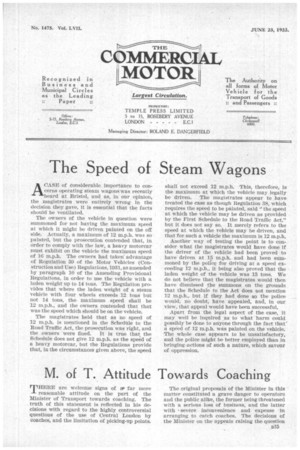The Speed of Steam Wagons
Page 29

If you've noticed an error in this article please click here to report it so we can fix it.
ACASE of Considerable importance to concerns operating steam wagons was recently heard at Bristol, and as, in our opinion, the magistrates were entirely wrong in the decision they gave, it is essential that the facts should be ventilated.
The owners of the vehicle in question were summoned for not having the maximum, speed at which it might be driven painted on the off side. Actually, a maximum of 12 m.p.h. was so painted, but the prosecution contended that, in order to comply with the law, a heavy motorcar must exhibit on the vehicle the maximum speed of 16 m.p.h. The owners had taken advantage of Regulation 59 of the Motor Vehicles (Construction and Use) Regulations, 1931, as amended by paragraph 10 of the Amending Provisional Regulations, In order to use the vehicle with a laden weight up to 14 tons. The Regulation provides that where the laden weight of a steam vehicle with four wheels exceeds 12 tons but not 14 tons, the maximum speed shall be 12 m.p.h., and the owners contended that that was the speed which should be on the vehicle.
The magistrates held that as no speed of 12 m.p.h. is mentioned in the Schedule to the Road Traffic Act, the prosecution was right, and the owners were fined. It is true that the Schedule does not give 12 m.p.h. as the speed of a heavy motorcar, but the Regulations provide that, in the circumstances given above, the speed shall not exceed 12 m.p.h. This, therefore, is the maximum at which the vehicle may legally be driven. The magistrates appear to have treated the case as though Regulation 38, which requires the speed to be painted, said " the speed at which the vehicle may be driven as provided by the First Schedule to the Road Traffic Act," but it does not say so. It merely refers to the speed at which the vehicle may be driven, and that for such a vehicle the maximum is 12 m.p.h.
Another way of testing the point is to consider what the magistrates would have done if the driver of the vehicle had been proved to have driven at 15 m.p.h. and had been summoned by the police for "driving at a speed exceeding 12 m.p.h., it being also proved that the laden weight of the vehicle was 13 tons. We do not believe that the magistrates would then have dismissed the summons on the grounds that the Schedule to the Act does uot mention 12 m.p.h., but if they had done so the police would; no doubt, have appealed, and, in our view, that appeal would have been successful.
Apart from the legal aspect of the case, it may well be inquired as to what harm could possibly be done to anyone through the fact that a speed of 12 m.p.h. was painted on the vehicle. The whole case appears to be unsatisfactory, and the police might be better employed than in bringing .actions of such a nature, which savour of. oppression.




























































































